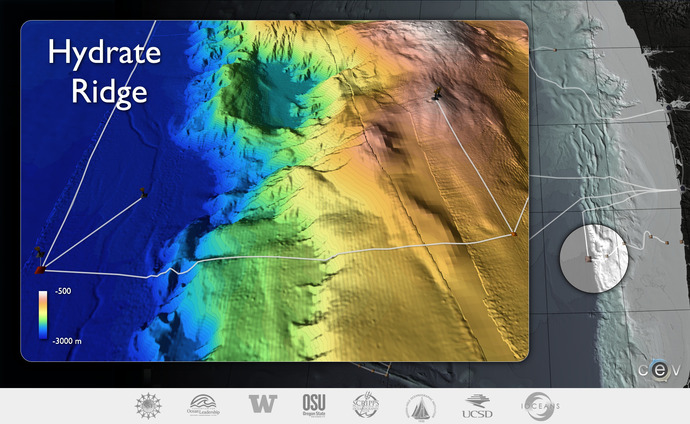Hydrate Ridge is a focal point for numerous interdisciplinary studies that address process linkages associated with gas hydrate formation, the flow of carbon from the crust and from the coast to the deep sea, and the linkages among biogeochemical processes and climate change in one of the most biologically productive areas in the world’s oceans. Hydrate Ridge has also been the site of Ocean Drilling Program (ODP) Legs 146 (Site 892) and 204 (Site 1249). RSN infrastructure at this site includes two Primary Nodes (Hydrate Ridge and Southern Hydrate Ridge).
This site also provides high power (10 kv) and bandwidth (10 Gb/s) capabilities to the Endurance Array Oregon Line through Primary Node 1C. Sensors at this site meet requirements outlined in the the OOI Science Requirements documents for A-1 Global Biogeochemistry and Carbon Cycling, A-4 Fluid Rock Interaction and the Subseafloor Biosphere, A-5 Plate-Scale Seismology and Geodynamics, A-6 Gas Hydrates, A-7 Climate Variability and Ecosystems, A-8 Ocean Mixing and Rough Topography, and support requirements outlined in A-3 Ocean Circulation, Mixing, and Ecosystems, A-9 Coastal Ocean Dynamics and Ecosystems- Hypoxia on Continental Shelves, A-10 Coastal Ocean Dynamics and Ecosystem Shelf/Slope Exchange. To meet these requirements 10 different types of seafloor sensors are hosted at the southern summit Hydrate Ridge sites, as well as those on the wtaer-column mooring (see below) hosted at the base of the margin. This site has strong geological, chemical and physical oceanographic linkages that also allow understanding of processes operative upslope and monitored by the Coastal Endurance array.
Mooring
The mooring at Hydrate Ridge is situated adjacent to the coastal continental slope at the end of the Endurance Oregon Line, and in concert with the northern Endurance Washington Line, provides a unique opportunity for investigating a variety of interdisciplinary coastal studies. The coastal region of the Pacific Northwest is a classic wind-driven upwelling system. However, the presence of the Columbia River plume and the range of trajectories with which it can impinge on the ocean, and the strong variability of the width of the continental shelf, all play strong roles in setting the system’s response and behavior. In addition, the aforementioned large-scale systems affect the coastal region by modulating the pycnocline, nutricline and oxycline depths and offshore pressure gradients, which in turn affect the onshore transport of physical, biological and chemical quantities. The presence of internal waves driven by waves and tides, their interaction with the larger-scale currents, and their eventual breakdown into turbulence, are also vital to setting properties in the coastal region. All of these are expected to change strongly over time, but will be well resolved by the measurements at Hydrate Ridge, the Endurance Array, and supporting shipboard work.

